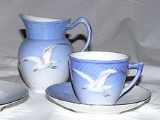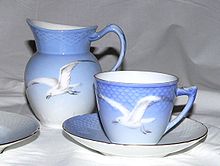
Bing & Grøndahl
Encyclopedia
Bing & Grøndahl was a Danish
porcelain
manufacturer founded in 1853 by the sculptor Frederik Vilhelm Grøndahl and merchant brothers Meyer Hermann Bing and Jacob Herman Bing. The trademark backstamp for Bing & Grøndahl (B&G) porcelains is the three towers derived from the Coat of Arms of Copenhagen
. The company's Seagull dinnerware series became known as the "National Service of Denmark" in the 1950s when it was found in one tenth of all Danish households. In 1987 the company merged with its primary competitor, the Royal Porcelain Factory under the name Royal Copenhagen
.
area, at that time outside the city of Copenhagen
, Denmark
. Grøndahl initially began the company to produce bisque
figurines modeled on the neoclassical
sculptures of Thorvaldsen. The company extended production to include high style dinnerware and coffee sets.
 The company's signature design, Seagull, was created in 1892 by designer Fanny Garde (1855-1925). The modest, classic design features flying seagulls against pale blue backgrounds, sea horse handles and shaded patterns of scales around the edges. Due to its popularity from the 1950s to the 1980s, the Seagull design was considered the "National Service of Denmark". During that period one out of every ten Danish households owned some of the dinnerware service.
The company's signature design, Seagull, was created in 1892 by designer Fanny Garde (1855-1925). The modest, classic design features flying seagulls against pale blue backgrounds, sea horse handles and shaded patterns of scales around the edges. Due to its popularity from the 1950s to the 1980s, the Seagull design was considered the "National Service of Denmark". During that period one out of every ten Danish households owned some of the dinnerware service.
In 1895, Bing & Grøndahl created the first in their series of Christmas plates. Designed with a traditional winter scene in cobalt blue and white, the plates have been released annually for more than 100 years. Noted as desirable by collectors, this series became responsible for a large portion of the company's production.
In 1987 the company merged with its primary competitor, the Royal Porcelain Factory under the name Royal Copenhagen
.
Denmark
Denmark is a Scandinavian country in Northern Europe. The countries of Denmark and Greenland, as well as the Faroe Islands, constitute the Kingdom of Denmark . It is the southernmost of the Nordic countries, southwest of Sweden and south of Norway, and bordered to the south by Germany. Denmark...
porcelain
Porcelain
Porcelain is a ceramic material made by heating raw materials, generally including clay in the form of kaolin, in a kiln to temperatures between and...
manufacturer founded in 1853 by the sculptor Frederik Vilhelm Grøndahl and merchant brothers Meyer Hermann Bing and Jacob Herman Bing. The trademark backstamp for Bing & Grøndahl (B&G) porcelains is the three towers derived from the Coat of Arms of Copenhagen
Coat of arms of Copenhagen
The coat of arms of Copenhagen was granted 24 June 1661 by king Frederick III of Denmark in appraisal of its citizens' efforts in repelling the Swedish siege and attack on Copenhagen in 1658-1659...
. The company's Seagull dinnerware series became known as the "National Service of Denmark" in the 1950s when it was found in one tenth of all Danish households. In 1987 the company merged with its primary competitor, the Royal Porcelain Factory under the name Royal Copenhagen
Royal Copenhagen
Royal Copenhagen, officially the Royal Porcelain Factory is a manufacturer of porcelain products and was founded in Copenhagen 1 May 1775 under the protection of Queen Juliane Marie...
.
History
Bing & Grøndahl was founded on April 15, 1853, by Grøndahl, who was a figurine maker for the Royal Danish Porcelain Factory, and the Bing brothers, who were art and book dealers. The factory was located on the corner of Vesterbrogade and Rahbek Allé in the VesterbroVesterbro
Vesterbro is one of the 15 administrative, statistical, and city tax districts comprising the municipality of Copenhagen, Denmark...
area, at that time outside the city of Copenhagen
Copenhagen
Copenhagen is the capital and largest city of Denmark, with an urban population of 1,199,224 and a metropolitan population of 1,930,260 . With the completion of the transnational Øresund Bridge in 2000, Copenhagen has become the centre of the increasingly integrating Øresund Region...
, Denmark
Denmark
Denmark is a Scandinavian country in Northern Europe. The countries of Denmark and Greenland, as well as the Faroe Islands, constitute the Kingdom of Denmark . It is the southernmost of the Nordic countries, southwest of Sweden and south of Norway, and bordered to the south by Germany. Denmark...
. Grøndahl initially began the company to produce bisque
Bisque
Bisque may refer to:* Bisque , a piece of unglazed pottery* Bisque , a thick, creamy soup made from puréed seafood or vegetables* Bisque, a free turn in a handicap croquet match* Bisque, a free point in a handicap real tennis match...
figurines modeled on the neoclassical
Neoclassicism
Neoclassicism is the name given to Western movements in the decorative and visual arts, literature, theatre, music, and architecture that draw inspiration from the "classical" art and culture of Ancient Greece or Ancient Rome...
sculptures of Thorvaldsen. The company extended production to include high style dinnerware and coffee sets.

In 1895, Bing & Grøndahl created the first in their series of Christmas plates. Designed with a traditional winter scene in cobalt blue and white, the plates have been released annually for more than 100 years. Noted as desirable by collectors, this series became responsible for a large portion of the company's production.
In 1987 the company merged with its primary competitor, the Royal Porcelain Factory under the name Royal Copenhagen
Royal Copenhagen
Royal Copenhagen, officially the Royal Porcelain Factory is a manufacturer of porcelain products and was founded in Copenhagen 1 May 1775 under the protection of Queen Juliane Marie...
.
External links
- Royal Copenhagen official website
- Bing & Grondahl factory marks 1853 to 2003, The Art of Dating Bing & Grondahl, www.jamiri.dk

